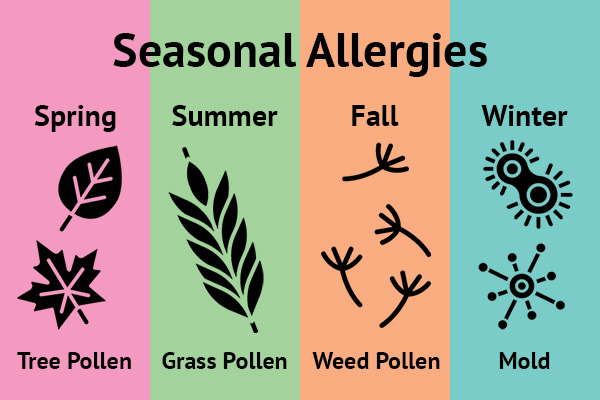Can dogs have allergies? The answer is yes. Like humans, allergies can be a problem and cause quite a bit of discomfort for dogs. Since dogs can’t say what’s wrong, it’s up to pet parents to look for the signs of allergies. So just how can you tell if your dog has allergies?
Signs of Allergies in Dogs
Dog allergy symptoms can range from mild to severe allergic reactions. Even mild cases will cause your dog to feel discomfort, so you should be able to recognize that something may be wrong. Generally, signs of allergies in dogs include:
Scratching and/or Biting
A typical sign of allergies in your dog is scratching and biting at their skin. Since dogs are predisposed to absorbing allergens through their skin, it’s typically the first place to have an allergic reaction. This type of reaction is known as atopic dermatitis, and the discomfort caused is similar to that of poison ivy or chicken pox on a human, causing a dog to bite or scratch to relieve the itchy sensation.
Paw Licking
If you notice your dog licking their paw compulsively, your pet may be suffering from allergies. A dog’s body will naturally push histamines, the chemicals in the immune system triggered by the allergen, to its extremities, such as the paws.
Scooting or Licking the Anus
Dogs may also experience uncomfortable itching in their hindquarters, similar to excessive paw itchiness. You may notice your dog licking their anus or scooting to try and relieve the constant itching.
Inflamed and/or Infected Skin
If dogs have allergies and continue to scratch, their skin can become more inflamed or infected. The affected skin area can develop secondary skin infections that will likely require specific medicine or antibiotics.
Ear Infections
Ear infections are a common allergy symptom. Signs of ear infections in dogs include:
- Discomfort
- Waxy ears
- Red ears
- Head shaking
Since ear infections can be painful for dogs and dangerous if left untreated, it’s best to take your pet to the vet as soon as possible.
Shedding
Excessive shedding is a common sign of pollen allergies in dogs and can often worsen with excessive scratching and skin infections. Dandruff can also be present with allergies since the allergies dry out a dog’s skin and cause it to flake.
Respiratory Issues
While not a common allergy symptom in dogs, respiratory issues can result from allergic reactions in dogs. Such respiratory problems can include:
- Trouble breathing
- Sneezing
- Wheezing
- Coughing
Respiratory issues are some of a dog’s most severe allergic reactions, causing an inability to breathe correctly. As such, they require immediate medical attention.
Seasonal Allergies vs. Food Allergies
You may have noticed that your dog is overly itchy and perhaps is frequently sneezing or has red, inflamed skin. The question then is the underlying cause – are those allergic reactions due to seasonal issues with pollens, mold spores, and the like, or might your dog’s food cause them?
Just like humans can have allergies to food, so can dogs. It can be challenging to know right away which type of allergies your dog is suffering from since both seasonal allergies and food allergies have similar symptoms. It’s essential to take your dog to your vet for a diagnosis to determine the exact cause of the allergic reaction.
In other parts of the country, veterinarians can sometimes distinguish seasonal versus food allergies by the time of year your dog experiences its symptoms. Food allergies tend to be year-round, so dogs who only experience symptoms during certain times of the year usually have a seasonal allergy. The difficulty for us is that, as many allergy sufferers in North Carolina know all too well, our “season” can last throughout the year.
Still, we can get some clues that may lead your veterinarian to suspect a food allergy. First is the time of life in which your pet starts to experience its symptoms. A food allergy is possible if a pet develops symptoms early or late in life, and the symptoms persist throughout the year. Most seasonal allergies, in contrast, show up in early adulthood. Seasonal allergies can also indeed be seasonal, at least at first. However, many pets will accumulate more seasonal allergies until they eventually experience their symptoms for most, if not all, of the year.
The only way to effectively determine whether your pet has a food allergy is to perform a strict diet trial with a hypoallergenic diet. A hypoallergenic diet trial involves far more than simply switching from one food to another. Your veterinarian can discuss the parameters of a diet trial and find a food appropriate for your pet.
Allergy Season for Dogs
We live in North Carolina – our allergy season can be every day! We tend to experience allergy symptoms from tree pollens in the spring, grass pollens in the summer, and weed pollens in the fall. Our damp winters also leave us susceptible to mold spores in the winter. Still, we tend to see a few more cases of allergy in the spring and late summer/early fall months than at other times of the year.

How to Relieve Your Dog’s Seasonal Allergy Symptoms
Seasonal allergies are often an unavoidable part of a dog’s life. While there’s no cure for these allergies, there are a few things you can do to prevent and treat seasonal allergy symptoms. Keeping a lookout for the common signs of seasonal allergies in dogs allows you to nip the symptoms before they worsen. At the first sign, see your veterinarian and get the right treatment plan. It can be challenging to identify and remove allergy triggers regarding environmental or seasonal allergies.
Non-Prescription Allergy Treatment Options
We do have a few non-prescription treatment options to help with allergy symptoms. If your pet’s symptoms are mild, these treatments might be all you need. However, most pets with seasonal allergies need veterinarian-prescribed medications to get to the cause and treat it effectively.
Non-prescription treatment options include over-the-counter antihistamines such as Benadryl or Zyrtec, frequent baths with a medicated hypoallergenic shampoo, and the omega-3 fatty acids from fish oils. However, products such as antihistamines and fish oils can also have adverse effects if dosed improperly, so ALWAYS be sure to speak with your veterinarian before giving these or any other over-the-counter product to your pet.
A few things to note about giving your dog Benadryl and other antihistamines for allergy relief:
ALWAYS check with your veterinarian before giving any over-the-counter product to your pet. Dosages for dogs and humans are not the same. Be sure to talk to your vet before giving your pet any over-the-counter medicine to ensure you give them the correct dosage and to ensure there won’t be any adverse reactions due to other medications your dog may be taking.
While antihistamines are generally safe for dogs, each dog reacts differently. They can cause hyperactivity in some dogs and drowsiness in others.
Be sure to check the label when buying over-the-counter medications for your dog, and make sure there are no other ingredients like pseudoephedrine or decongestants that aren’t safe for dogs.
Getting in to see your vet quickly is key
If you notice signs of allergies in your dog, schedule an appointment with your vet as soon as possible. The sooner the allergy symptoms are addressed, the quicker your pet can find allergy relief, and the more likely you will be able to control their seasonal allergies long-term.


